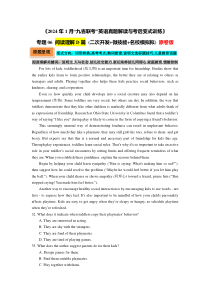 DOC
DOC
【文档说明】专题06 阅读理解D篇 (二次开发+微技能+名校模拟) 原卷本.docx,共(25)页,56.527 KB,由小赞的店铺上传
转载请保留链接:https://www.doc5u.com/view-d62c565600de35f545458ff588859e16.html
以下为本文档部分文字说明:
《2024年1月“九省联考”英语真题解读与考后变式训练》专题06阅读理解D篇(二次开发+微技能+名校模拟拟)原卷版变式方向:词形转换;高考考点;熟词新意;说明文选标题技巧;儿童教育话题阅读理解关键词:说明文,人与社会,幼儿社交能力,家长培养幼儿同理心,
家庭教育,情绪控制Forlotsofkids,toddlerhood(幼儿期)isanimportanttimeforfriendship.Studiesshowthattheearlierkidslearntoformpositiverelationship
s,thebettertheyareatrelatingtoothersasteenagersandadults.Playingtogetheralsohelpsthesekidspracticesocialbehaviors,suchaski
ndness,sharing,andcooperation.Evenso,howquicklyyourchilddevelopsintoasocialcreaturemayalsodependonhistemperament(性格).Someto
ddlersareverysocial,butothersareshy.Inaddition,thewaythattoddlersdemonstratethattheylikeotherchildrenismarkedlydifferentfromwhatadultsthinkofasexpr
essionsoffriendship.ResearchatOhioStateUniversityinColumbusfoundthatatoddler’swayofsaying“Ilikeyou”du
ringplayislikelytocomeintheformofcopyingafriend’sbehavior.Thisseeminglyunusualwayofdemonstratingfondnessca
nresultinunpleasantbehavior.Regardlessofhowmuchtheylikeaplaymate,theymaystillgrabhistoys,refusetoshare,andgetbossy.Bu
texpertssaythatthisisanormalandnecessarypartoffriendshipforkidsthisage.Throughplayexperiences,toddlerslearnsocialrules.That’swhyit'ssoimporta
nttotakeanactiveroleinyourtoddler’ssocialencountersbysettinglimitsandofferingfrequentremindersofwhattheyare.Whenyouestablishthese
guidelines,explainthereasonsbehindthem.Beginbyhelpingyourchildlearnsympathy(“Beniscrying.What'smakinghimsos
ad?”),thensuggesthowhecouldresolvetheproblem(“Maybehewouldfeelbetterifyoulethimplaytheball.”).Whenyourchildsharesorshowsempathy(同理心)towardafriend,
praisehim(“Benstoppedcrying!Youmadehimfeelbetter.”).Anotherwaytoencouragehealthysocialinteractionisbyencoura
gingkidstousewords-notfists-toexpresshowtheyfeel.It'salsoimportanttobemindfulofhowyourchild'spersonalityaffects
playtime.Kidsareeasytogetangrywhenthey’resleepyorhungry,soscheduleplaytimewhenthey’rerefreshed.32.Whatdoesitind
icatewhentoddlerscopytheirplaymates’behavior?A.Theyareinterestedinacting.B.Theyareshywiththestrangers.C.Theyarefon
doftheirplaymates.D.Theyaretiredofplayinggames.33.Whatdoestheauthorsuggestparentsdofortheirkids?A.Designgamesforthem.B.Findthemsuitableplaymates.C
.Playtogetherwiththem.原题呈现D.Helpthemunderstandsocialrules.34.Whatisthefunctionofthequotedstatementsinpa
ragraph4?A.Givingexamples.B.Explainingconcepts.C.Providingevidence.D.Makingcomparisons.35.Whichofthefollowingisthebesttitleforthetext?A.HowChildrenA
dapttoChangesB.HowtoBeaRoleModelforChildrenC.HowYourBabyLearnstoLoveD.HowtoCommunicatewithYourKid一、纲内词汇(酌情删减)1.positivea.2.
teenagern.3.behaviorn.4.cooperationn.5.creaturen.6.demonstratevt.7.markedlyad.8.expressionn.9.copyvt.10.seeminglyad.11.unusuala
.12.fondnessn.13.unpleasanta.14.normala.15.playmaten.16.grabvt.17.bossya.18.encountern.19.frequenta.20.remindern.21.establishvt.22.guidelinen.2
3.sympathyn.24.resolvevt.25.mindfula.26.personalityn.27.sleepya.28.refresheda.29.indicatevt.30.functionn.31.quotevt32.compa
risonn.33.evidencen.34.conceptn.二、高频词块(酌情删减)1.relateto2.inaddition3.intheformof4.resultin5.Regardlessof6.takeanactiverolein7.bemindfulof8.befondof
9.betiredof10.adaptto11.rolemodel12.communicatewith三、单句填空(核心考点习题化)1.Studiesshowthatthe__________(early)kidslearntoformpositiver
elationships,thebetter考点变式训练theyareatrelating__________othersasteenagersandadults.2.__________(play)togetherals
ohelpsthesekidspracticesocialbehaviors,suchaskindness,sharing,and__________(cooperate).3.How__________(quick)yourchilddev
elopsintoasocialcreaturemayalsodependonhistemperament(性格).4.Sometoddlersarevery__________(society),butot
hersareshy.5.In__________(add),theway__________thattoddlersdemonstratethattheylikeotherchildrenisdifferentfrom__________whatadultsthinkofasexpr
essionsoffriendship.6.ResearchatOhioStateUniversityinColumbusfoundthatatoddler’swayofsaying“Ilikeyou”duringplayislikely__________(come)in
__________formofcopyingafriend’sbehavior.7.This__________(seeming)unusualwayofdemonstratingfondnesscanresult__________u
npleasantbehavior.8.Regardlessofhowmuchtheylikeaplaymate,theymaystillgrabhistoys,refusetoshare,__________getbossy.9.Butexpertssaythatthisisa
normalandnecessarypartof__________(friend)forkidsthisage.10.That’swhyit'ssoimportant__________(take)anactiveroleinyourtodd
ler’ssocialencountersbysettinglimitsand__________(offer)frequentremindersofwhattheyare.11.Whenyouestablishtheseguidelines,ex
plainthereasonsbehind__________(they).12.Beginbyhelpingyourchildlearnsympathy,thensuggest__________hecouldresolvetheproblem.13.Anotherwa
y__________(encourage)healthysocialinteractionisbyencouragingkids__________(use)words.14.It'salsoimportantt
obemindfulof__________yourchild'spersonalityaffectsplaytime.15.Kidsareeasytogetangrywhenthey’resleepyorhun
gry,soscheduleplaytimewhenthey’re__________(refresh).四、熟词新意(develop用法)1.Thecompanydevelopsandmarketsnewsoft
ware.2.Hersondevelopedasthmawhenhewastwo.3.ThesiteisbeingdevelopedbyaFrenchcompany.4.Shedevelopsthethememor
efullyinherlaterbooks.5.Ihadthefilmdevelopedyesterday.五、长难句分析(括号法+标记法)1.ResearchatOhioStateUniversityinColumbusfound[thatatoddler’swayo
fsaying“Ilikeyou”duringplayislikelytocomeintheformofcopyingafriend’sbehavior].【翻译】哥伦布俄亥俄州立大学的研究发现,一个蹒跚学步的孩子在玩耍时说“我喜欢你”的方式
很可能是模仿朋友的行为。【分析】found后边that引导_______从句;intheformofcopyingafriend’sbehavior是介词短语作_______。2.Thedifferences[inconversationalstyles]becameevident[when
participantslistenedtoaudioclips][inwhichtwopeoplespokeatthesametimebutwereagreeingwitheachotherandsta
yedontopic],Hiltonsaid.【翻译】希尔顿说,当参与者听音频片段时,对话风格的差异变得明显,在音频片段中,两个人同时说话,但彼此意见一致,并保持话题不变。【分析】介词短语inconversationalstyles作状语;when…引导_______从句:inwhich
…引导_______从句修饰先行词audioclips。Weallknowthatunpleasantfeelingwhenwe’retalkingaboutsomethinginterestingandhalfwa
ythroughoursentencewe’reinterrupted.Butwasthatreallyaninterruption?Theanswerdependsonwhomyouask,accordingtonewresearchledb
yKatherineHiltonfromStanfordUniversity.Usingasetofcontrolledaudioclips(录音片段),Hiltonsurveyed5,000AmericanEnglis
hspeakerstobetterunderstandwhataffectspeople’sperceptionsofinterruptions.Shehadparticipantslistentoaudio
clipsandthenanswerquestionsaboutwhetherthespeakersseemedtobefriendlyandengaged,listeningtooneanother,ortryingtointerrupt
.HiltonfoundthatAmericanEnglishspeakershavedifferentconversationalstyles.Sheidentifiedtwodistinctgroups:higha
ndlowintensityspeakers.Highintensityspeakersaregenerallyuncomfortablewithmomentsofsilenceinconversation
andconsidertalkingatthesametimeasignofengagement.Lowintensityspeakersfinditrudetotalkatthesametimeandpre
ferpeoplespeakoneafteranotherinconversation.Thedifferencesinconversationalstylesbecameevidentwhenparticipantslistenedt
oaudioclipsinwhichtwopeoplespokeatthesametimebutwereagreeingwitheachotherandstayedontopic,Hiltonsaid.Thehighi
ntensitygroupreportedthatconversationswherepeoplespokeatthesametimewhenexpressingagreementwerenotinterruptivebutengagedandfriendlierthantheconvers
ationswithmomentsofsilenceinbetweenspeakingturns.Incontrast,thelowintensitygroupperceivedanyamountofsimultaneous(同时)chatasarudeinterru
ption,regardlessofwhatthespeakersweresaying.“Peoplecareaboutbeinginterrupted,andthosesmallinterruptionscanhaveamassiveeffectonthe
overallcommunication,”Hiltonsaid.“Breakingapartwhataninterruptionmeansisessentialifwewanttounderstandhowhumansinteractwitheachother.”
32.WhatdoesHilton’sresearchfocuson?A.Whatinterruptionsmeantopeople.B.Whetherinterruptionisgoodornot.C.Howtoavoidgettinginterrupted.2023年四省联考DWhy
speakersinterrupteachother.33.Whatdoparticipantsofthestudyneedtodo?A.Recordanaudioclip.B.Answersomequestions.C.Listentooneanother.D.Have
achatwithafriend.34.Whatdolowintensityspeakersthinkofsimultaneouschat?A.It’simportant.B.It’sinteresting.C.It’sineffici
ent.D.It’simpolite.35.WhatcanwelearnfromHilton’sresearch?A.Humaninteractioniscomplex.B.Communicationisthebasisoflife.C.I
nterruptionspromotethinking.D.Languagebarrierswillalwaysexist.说明文如何选标题一、说明文标题三大特点1.概括性:语言高度凝练而形式简短2.针对性:标题外延与文章内容相符3.醒目性:能够激发读者的阅读欲望二、说明文选标题三大方法1.主题段
法标题段一般在文章的第一段和最后一段,一般来说第一段经常提出文章的主题或最后一段总结文章的主题,知道了文章的主题也就知道了文章的中心,把中心概括成一句话或一个短语即是文章的标题。2.主题句法解题的关键要抓住每段的首尾句,要注意贯穿文章始终的词语。通过
寻找文章的主题句,并对主题句进行概括和提炼,从而确定文章的标题。2.关键词法任何一篇文章都是围绕某个主题展开的,因此有的文章中最明显的特点之一是有一个反复出现的中心词,即关键词,也叫做主题词。抓住了它,便容易抓住文章的中心。三、说明文选标题三大策略1.正
面肯定法在理解文章主旨的基础上,揣摩哪个选项能准确概括主旨。2.反面否定法撇开原文,拿各个备选项去尝试用它们写出来的“文章”将是什么内容,然后和原文对照,一一排除荒谬者。3.排除干扰法研究干扰项里面的中心词、修饰词的变化、结构、新奇性、概括性等。文章的标题应该新颖解题指导奇特,易激发读者的好奇
心,吸引读者注意力。四、说明文标题错误三大特征1.范围太宽泛选项太过于宽泛,与文章内容相距甚远。2.范围太具体选项死扣文章某一细节不适合用于标题。3.范围太偏颇选项内容过于偏颇,明显偏离文章主旨。五、说明文选标题三大关
注点1.文章结构“倒三角形▼”结构特点,首段最重要,越往后重要性越低。因此结合写作对象看首段和尾段,以首段为主是选好说明文类阅读理解题的基本功。2.选项规律说明文选标题四个选项多采用二元法,两个比较接近正确答案甚至相反,干扰性强,两个往往和主题关联性较弱,容易排除。3.做后反思实践证
明说明文最后一题往往是压轴题也是高频错题,因此保持做后反思是提高选标题能力的必然途径。考例(2024年1月浙江首考卷)TheStanfordmarshmallow(棉花糖)testwasoriginallyconduc
tedbypsychologistWalterMischelinthelate1960s.Childrenagedfourtosixatanurseryschoolwereplacedinaroom.Asinglesugarytreat,select
edbythechild,wasplacedonatable.Eachchildwastoldiftheywaitedfor15minutesbeforeeatingthetreat,theywouldbegivenasecondtreat.Thentheywereleftaloneinth
eroom.Follow-upstudieswiththechildrenlaterinlifeshowedaconnectionbetweenanabilitytowaitlongenoughtoobtainas
econdtreatandvariousformsofsuccess.Asadultswefaceaversionofthemarshmallowtesteveryday.We’renottempted(诱惑)
bysugarytreats,butbyourcomputers,phones,andtablets—allthedevicesthatconnectustotheglobaldeliverysystemforvarioustypeso
finformationthatdotouswhatmarshmallowsdotopreschoolers.Wearetemptedbysugarytreatsbecauseourancestorslivedinacalorie-poorw
orld,andourbrainsdevelopedaresponsemechanismtothesetreatsthatreflectedtheirvalue—afeelingofrewardandsatisf
action.Butaswe’vereshapedtheworldaroundus,dramaticallyreducingthecostandeffortinvolvedinobtainingcalories,westillhavethesamebrainswehadthousandsofy
earsago,andthismismatchisattheheartofwhysomanyofusstruggletoresisttemptingfoodsthatweknowweshouldn’teat.Asimilarprocessisatworkinourresp
onsetoinformation.Ourformativeenvironmentasaspecieswasinformation-poor,soourbrainsdevelopedamechanismthatprizednewinformation.Butglob
alconnectivityhasgreatlychangedourinformationenvironment.Wearenowceaselesslybombarded(轰炸)withnewinformation.Therefore,justaswen
eedtobemorethoughtfulaboutourcaloricconsumption,wealsoneedtobemorethoughtfulaboutourinformationconsumpti
on,resistingthetemptationofthemental“junkfood”inordertomanageourtimemosteffectively.32.Whatdidthechildrenneedtodotogetasecondt
reatinMischel’stest?A.Takeanexaminationalone.B.Showrespectfortheresearchers.C.Sharetheirtreatswithothers.D.Delayeatingforfifteenmi
nutes.33.Accordingtoparagraph3,thereisamismatchbetween_______.A.thecalorie-poorworldandourgoodappetitesB.theshortageofsugarandour
nutritionalneedsC.therichfoodsupplyandourunchangedbrainsD.thetemptingfoodsandoureffortstokeepfit34.Whatdoestheauthorsuggestreadersdo?A.Absorbnew
informationreadily.B.Beselectiveinformationconsumers.C.Usediverseinformationsources.D.Protecttheinformationenvironment.35.Whichofthefollo
wingisthebesttitleforthetext?A.EatLess,ReadMoreB.TheBitterTruthaboutEarlyHumansC.TheLater,theBetterD.
TheMarshmallowTestforGrownups1(2029年全国I卷)Duringtherosyyearsofelementaryschool(小学),Ienjoyedsharingmydollsandjokes,whichallowedm
etokeepmyhighsocialstatus.Iwasthequeenoftheplayground.Thencamemytweensandteens,andmeangirlsandcoolkids.Theyroseintheranksnotbybeingfriendlybutbysm
okingcigarettes,breakingrulesandplayingjokesonothers,amongwhomIsoonfoundmyself.Popularityisawell-exploredsubjectinsocialpsychology
.MitchPrinstein,aprofessorofclinicalpsychologysortsthepopularintotwocategories:thelikableandthestatusseekers
.Thelikables’plays-well-with-othersqualitiesstrengthenschoolyardfriendships,jump-startinterpersonalskillsand,whentappedearly,areemployed
everafterinlifeandwork.Thenthere’sthekindofpopularitythatappearsinadolescence:statusbornofpowerandevendishonorablebehavior.Enviableasthecoolki
dsmayhaveseemed,Dr.Prinstein’sstudiesshowunpleasantconsequences.Thosewhowerehighestinstatusinhighschool,aswellasthoseleastlikedinelementar
yschool,are“mostlikelytoengage(从事)indangerousandriskybehavior.”历年真题速递Inonestudy,Dr.Prinsteinexaminedthetwotypesofpopularityin235adolescents,
scoringtheleastliked,themostlikedandthehighestinstatusbasedonstudentsurveys(调查研究).“Wefoundthattheleastwell
-likedteenshadbecomemoreaggressiveovertimetowardtheirclassmates.Butsohadthosewhowerehighinstatus.Itclearlysho
wedthatwhilelikabilitycanleadtohealthyadjustment,highstatushasjusttheoppositeeffectonus."Dr.Prinsteinhasalsofoundthatthequalitiesthatmadeth
eneighborswantyouonaplaydate-sharing,kindness,openness—carryovertolateryearsandmakeyoubetterabletorelateandconn
ectwithothers.Inanalyzinghisandotherresearch,Dr.Prinsteincametoanotherconclusion:Notonlyislikabilityrelatedtopositivelifeou
tcomes,butitisalsoresponsibleforthoseoutcomes,too."Beinglikedcreatesopportunitiesforlearningandfornewkindsoflifeexperiencesthathelps
omebodygainanadvantage”hesaid.32.Whatsortofgirlwastheauthorinherearlyyearsofelementaryschool?A.Unkind.B.Lonely.C.Generous.D.Cool.33.Whatist
hesecondparagraphmainlyabout?A.Theclassificationofthepopular.B.Thecharacteristicsofadolescents.C.Theim
portanceofinterpersonalskills.D.Thecausesofdishonorablebehavior.34.WhatdidDr.Prinstein’sstudyfindaboutthemostlikedkids?A.Theyappearedtobeaggress
ive.B.Theytendedtobemoreadaptable.C.Theyenjoyedthehigheststatus.D.Theyperformedwellacademically.35.Whatisthebesttitleforthetext?A.BeNice-
-YouWon’tFinishLastB.TheHighertheStatus,theBeerC.BetheBest--YouCanMakeItD.MoreSelf-Control,LessAggressiveness1(2023上·湖南衡阳一中联考
期中)Whycan’tyourememberbeingababy?WillthattriptoDreamworldbewastedonyourtoddler(学步的幼儿)?Scientistsexplainhowthebrainchangesfrominfancy(婴儿期)throughtoea
rlychildhood,andwhatthismeansforyourchild’smemories.Whilesomepeoplecanremembermemoriesfromasearlyasagetwo,asadul
tsmostofusrarelyrememberthingsthathappentousbeforetheageofthree,duetoaphenomenoncalled“infantileamnesia(婴儿健忘症)”.Generally,wetendtoha
vevague(模糊的)memoriesofeventsthatoccurbetweentheagesofthreeandseven.Sowhyisitthatwecan’trememberbeingababy,oratoddler?Theanswerliesinthewayth
atourbrain’sabilitytostorememorieschangesaswegrow.Atbirth,ababy’sbrainisonlyaquarterofitsadultsize,grow
ingtothree-quartersthesizeofanadultbrainbyagetwo.Thisincreasecorrelateswithagrowthinthenumberofbraincells—calledneurons(神经元)一andtheco
nnectionsbetweenthesecells.Apartofthebrainthatisimportantinformingmemoriesisthehippocampus(海马体),says名校好题模拟DrDhanishaJhaveri,arese
archerattheQueenslandBrainInstituteatTheUniversityofQueensland.“Inthehippocampus,newneuronsareconstantlybeingcreated.Inadulthood,newcellsarestill
beingproduced,buttherateofproductioninthehippocampusslowsdown,”saysDrJhaveri.Neuroscientistsbelievethatthera
pidrateatwhichbraincellsarebeingproducedinchildhoodcouldbethecauseofinfantileamnesia.Becausesomanynewneuron
sarebeingproducedandformconnectionswitheachotherinmemorycircuits(记忆电路),theymightdisturbexistingnetworksofmemoriesthathaveal
readyformed.Butitturnsoutthatachild’sabilitytorememberthingsforlongperiodsoftimeimprovesgraduallythroughoutc
hildhood.Forexample,instudiesinwhichyoungkidsweretaughttoimitateanaction,six-month-oldscouldrememberwhat
todofor24(butnot48)hours,whilenine-month-oldscouldrememberwhattodoonemonth(butnotthreemonths)later.Desp
itethismemoryloss,childhoodexperienceshavebeenfoundtoinfluenceadultbehaviouryearslater,whichsuggeststhattracesofthesememoriescou
ldbestoredsomewhereinthebrainthatisn’teasytoaccess.SowhileyourkidsmightnotrecalltheirmajormilestonesorbetooyoungtorememberatriptoDis
neyland,positiveexperiencesastoddlersorininfancymaycontinuetoaffecttheirbehaviourlongafterthey’veforgottenthem.1.Whatcanbeinferredfromparagraph3?A.O
urbrain’sabilitytostorememoriesremainsunchangedaswegrow.B.Thesizeofthechild’sbrainbyagetwoistwicethesizeatbir
th.C.Thegrowthinthenumberofneuronswillinfluencethesizeofthechild’sbrain.D.Neuronshavenothingtodowithaperson’smemo
ry.2.Whatisthecauseofinfantileamnesiaaccordingtotheneuroscientists?A.Therapidrateofbraincellsbeingproduced.B.Theexistingnetworksofm
emories.C.Thewayofourbrainstoringmemories.D.Thememorycircuitsofourbrain.3.Whatisparagraph6mainlyabout?A.Childhoodexperien
ceswillinfluenceadultbehaviouryearslater.B.Tracesofthesememoriescouldbestoredsomewhereinthebrain.C.Achild’sabilitytoremembert
hingsimprovesgraduallyovertime.D.Theyoungerababyis,thebetteritsmemoryis.4.Whatistheauthor’sattitudetowardstheinfluenceofchildhoodexperiencesonadult
behaviouryearslater?A.Subjective.B.Objective.C.Pessimistic.D.Uncaring.2(2023上·甘肃天水·高三校考阶段练习)Toddlers(学步的儿童)goingtonurseryatApplesandHoneyNight
ingaledon’tjustspendtheirdaysinteractingwithotheryoungchildren,theyalsobuildrelationshipswiththebuilding’s
elderlyresidents.Intergenerationalnurseries,oneswhichsharespaceswithacarehomehavebeenshowntoreducelonelinessinolderpeopleandboosttheir
mentalandphysicalhealth.ButparentswhosechildrenattendApplesandHoneyNightingaleinClapham,London,havebeenpleasedtoseethebenefitsgob
othways.Bridgingthegapbetweengenerationshasintroducedtheirtoddlerstoanewrangeoflifeskills.LeanneRhodestwo-year-oldsonAndyhasbeeninthenur
seryfortwomonths.“HislanguageskillshaveimprovedandI’venoticedsomenewphrases,suchashimsayingyou’rewelcomewhen
someonesaysthankyoutohim.Also,I’venoticedhehasmoreconfidencearoundolderpeopleandwillsayhellotothemwhenweareout,thoughhehaspre
viouslyignoredthem,saidthe33-year-oldfromSolibull.StephenBurke,directorofUnitedForAllAges,anorganisatio
nthatworkstobringpeopletogetheracrossgenerations,sayscontactwithcarehomeresidentscanhelpdevelopchildren’sunderstandingofageingandissuesaffectin
golderpeople,especiallyiftheydon’thaveolderrelativeslivingcloseby.The2016BritishIntegrationSurveyfoundthatthoseagedunder18aretakingupjust24%o
fopportunitiestomixsociallywiththosefromadifferentgenerationtothemselves.Thoseaged65andoldertakeup59%ofsuchopportunities,bu
tthishasfallenfrom63%in2014.“Buildingcarehomesbynurseriesandschoolscouldhelpchangethat,”saysBurke.90-year-oldFayGarcia
isaresidentofNightingaleHouseCareHomeandhasnochildrenofherown.“Spendingtimewiththechildrenisoneofmybiggestpleasuresinthe
home,”shetoldHuffPostUK.“GettingtoknowthechildrenisanabsolutejoyandnowIfeelasthoughtheyarepartofmyfamilyIloveitwhenwehavecookerysessionsandIfeelg
reatteachingthekidshowtodecoratethecakes.”5.WhatisspecialaboutApplesandHoneyNightingale?A.itisruninthegroundsofacarehome.B.Ith
ireselderlypeopleasnurseryteachers.C.Itexposeschildrentopeoplefromallwalksoflife.D.Itaimstobridgethegapbetweenki
dsandparents.6.WhatdoesRhodessayaboutAndy’snurserylife?A.Ithaseasedhisloneliness.B.Hehasimprovedalotsocially.
C.Hehasbecomemoretalkative.D.Ithasdevelopedhisstrongpersonality.7.Whatdoes“that”underlinedinparagraph4referto?A.Theageingofthepop
ulation.B.Fewersocialopportunitiesfortheelderly.C.Childrenlivingfarawayfromtheiroldrelatives.D.Peoplehavinglittl
econtactwithothergenerations.8.HowdoesspendingtimewithchildrenaffectGarcia?A.Itliftsherspirits.B.Itteacheshernewskills.C.Itinspiresheri
nterestincooking.D.Itremindsherofherownchildren.3(2023上·江苏·高二江苏省运河中学校考阶段练习)It’sthecommonbedtimepracticeeveryparentisworriedabout—beingaskedtoreadt
hesamebooknumeroustimes.Butwhiletheconstantrepetitionmightbeextremelyboringformumsordads,itisthebestwayfortoddlers(学步的小
孩)tolearnnewwords,accordingtoresearch.Thefindingssuggestparentsarewastingmoneybyspendingafortuneonhugebookcollectionsinthehop
ethattheywillinspiretheirlittleones.Instead,asmallselectionoffavouritessuchasTheVeryHungryCaterpillarorTheGruffalowillachievefarm
ore.DrJessicaHorstoftheUniversityofSussex’sWORDLabandhercolleaguesconductedanexperimenttocheckhowquicklythree-year-old
kidscouldrecognizeandrecallsixnewwords.Thechildrenwerevisitedthreetimesinaweekattheirhomes.Onegroupheardthesamestorythr
eetimesback-to-backeachtimeandanotherwasreadthreedifferentstories.Allhadthesameamountofnewwords.Whenresearcher
sreturnedaweeklater,theyfoundthechildrenwhoheardthesamestoryoverandoveragainbadtypicallylearned3.6ofthenewwords.Thosethatwereexpos
edtoavarietyofstoriesrememberedonly2.6.Theyalsosaidthechildreninthe“repetition”grouplearnedatafasterratethanthosein
the“variety”group.ThefindingsbackpreviousresearchbyDr.Horstthatpointedtothebenefitsoffamiliarity.Shehasalreadyintroducedthetechniquetoher19-
month-oldson,“Ireadthesamebookstohim.Sometimes,everysingledayhewantsthesamebooks,”shesaid,“Weareshowingthatlessismore.Obviously,themoretimesyoure
adtoachild,themorebooksyouhavewillhelpthem.Butyoudon’tneedtogocrazyandbuyeverysingleThomastheTankEnginebo
ok.Readingthesamebooksoverandoveragainhelps.”Previousstudieshavefoundparentsspendjust49minutesdoingthi
ngswiththeirchildreneachday.Oneinthreedoesn’treadtotheirchildrenbeforeputtingthemtobedatnight.Yet30minutesofone-on-oneliteracy(识字)sessionscani
mprovereadingagebynearlytwoyearsinlessthanfivemonths.9.Whatshouldparentsdotobenefitkidsmostduringbedtim
estory-telling?A.Readmorebooks.B.Teachnewwords.C.Repeatthesamestory.D.Makethemselvesheard.10.HowdidDrJessicaHorstandherteamgettheirfindings?A.Byre
ferringtotheoriginalstudy.B.Bydividingchildrenintogroups.C.Byexperimentingwithsomekids.D.Byinterviewingparentsrandomly.11.What’
stheauthor’spurposeinwritingthispassage?A.Togiveyoungparentspracticaladvice.B.Toencourageparentstobuymorebooks.C.Toteachchildrenhowtoread
astorybook.D.Tohighlighttheimportanceofreadingmore.12.Whichofthefollowingwouldbethebesttitleforthetext?A.Repetitionmeansabiggerv
ocabularyB.BedtimereadingmakesabigdifferenceC.NewwordspreventdeepunderstandingD.Childrenshouldspendmoretimereading4(2020上·陕西榆林·高二校考期中)Statistics
showthatmosttoddlers(刚学走路的小孩)learnhowtosayabout20wordsby18months.Talkingiseasy.Ifyouaskanyone,nonewillrememberhowtheystarteddoingit,it
justcomesnaturally.Butwhatmightnotflowassmoothlyaswords,isbodylanguage.It’sawholedifferentdealwhenyou’reusingyourhands,eyesorheadinsteadofyou
rtongue.Andwhatmakesitevenmorecomplicatedisthefactthatbodylanguagediffersallaroundtheworld.Ifinditshockinglyamazinghow
justasmallfingergesturecouldmeanonethingintheEastandthecompletelyoppositeintheWest.Forinstance,inJapanbowingisthemostcommongreeting.Itshowsrespectan
dJapanesepayalotofattentiontothedetailslikethetiming,postureandmovement.AbowinJapanrepresentssincerity,respectandgraciousn
ess.WhileinNewZealandMaorithepressingofnosesandforeheadsisthetraditionalgreeting.Theycallit“hongi”,whic
hisregardedasthebreathoflife.Formostofus,noddingourheadupanddownoftenmeansagreement,butnotfortheBulgariansorGreeks.Inbothcultu
res,noddingone’sheadupanddownactuallymeans“no”.TheAmericangoodbyewavecouldactuallybeinterpreted(领会)asa“no”inmanypartsof
EuropeandLatinAmerica.AndtheItaliangoodbyewavewouldbeunderstoodinAmericaasa“comehere”andtheAmerican“comehere”gesturewouldact
uallybeseenasaninsult(侮辱)inmostofAsia.Sobeforeyoutraveltoexploreadifferentculture,makesureyou’reawareofalternatemeaningsfor
bodylanguage.Weliveinaworldwithmanydifferentcultures,sodon’tforgethowdifferentlyonehandgesturecanbeinte
rpreted!13.Whatmakesbodylanguagemisunderstoodoften?A.Itswideuses.B.Itssmoothflowing.C.Itsdifficultiesinunderstanding.D.Thebackgroundofd
ifferentcultures.14.WhatdoesthepressingofnosesandforeheadsmeaninNewZealand?A.Greeting.B.Respect.C.Tradition.D.Breath.15.Inwhi
chcountrydoesnoddingmean“no”?A.America.B.Greece.C.NewZealand.D.Japan.16.Whatcanbeasuitabletitleforthetext?A.TheOriginofBodyLanguageB
.TheLimitationofCultureC.BodyLanguageAroundtheWorldD.TheCultureofMaori5(2023下·湖北黄冈·高二校联考期中)Newresearchhasfoundadirectcorrelatio
nbetweenhowachildvisuallytrackshismother’seyesandthecondition.Howatoddlerrespondstobabytalkcouldhelpdiagnoseautism(自闭症)yearsbeforesymptomsbeg
in,accordingtothenewresearch.Astudyexaminedresponsestoparents’useofplayful,emotional,exaggeratedtones,knownas“motherese”(mother’s‘babytalk’
),tocaptureachild’sattention.Eye-trackingtestsshowedthatchildrenwhodidnotrespondhadweakersocialandlanguageabilit
ies.ProfessorKarenPierce,ofCaliforniaUniversityinSanDiego,co-authoroftheresearch,said,“Weknowtheearli
erwecanintroducetreatment,themoreeffectiveitislikelytobe.Butmostchildrendon’tgetaformaldiagnosisuntilaroundtheageofthreeorfour.Thereisarealneedforeas
yandeffectivetoolsthatcanbeusedonyoungchildren.Eye-tackingisagreatplacetostart.”Inexperiments,653toddlersagedonetotwoyearsoldwereexpose
dtotwoone-minutevideosfeaturingawomanspeakingmothereseorabstractscenes.Theireyescontrolledwhichoneplayed.ParticipantswithoutASD(autismspectrumdisor
der)showedconsistentlyhighinterestinthewomanspeakingmotherese,spendinganaverage80percentofthetimewatc
hingit.Theylargelyignoredthesecondvideowhichshowedabusyhighway,abstractshapesandnumbersandhadaccompanyingelectro
nicmusic.However,attentionlevelsofpeersdiagnosedwithASDspannedthefullrangeofconcentrationlevels,withsomefocusing100percentontherandomimages.Agroupwho
fixedonmothereselessthan30percentofthetimecouldbeaccuratelyidentifiedashavingASDthroughthismeasurementalon
e.Thesechildrenalsoshowedlowerscoresonsubsequenttestsoflanguageandsocialskills.Whetherlessattentiontomoth
ereseisthecauseofreducedsociabilityormerelyasymptomhasyettobedetermined.However,researchersfounditappearst
obeahighlyaccuratebiomarkerforthecondition.ProfPiercesaid,“Thefactwecanreliablyidentifychildrenwithautismusingsuchasimpleandrapideye-trackingtesti
sreallyremarkable.Infuture,wehopetouseachild’sattentiontomothereseasaclueforwhichtreatmentstheymaymostbene
fitfromandasatoolformeasuringhowwellthosetreatmentswork.”17.Whatisthepurposeofthestudy?A.Todiagnoseautismearly.B.Tocheckachild’s
eyesight.C.Totestachild’sreactiontomotherese.D.Tocatchachild’sattention.18.WhatcanweknowaccordingtoPierce
?A.Eye-trackingtestisagoodwaytocureautism.B.ItisessentialtobringinASDtreatmentinearlytime.C.Thereisanurgentneed
forcomplextoolappliedtoyoungchildren.D.Mostchildrendon’tgetaninformaldiagnosisbeforetheageofthreeorfour.19.HowdidparticipantswithoutASDresponde
dtothevideosinexperiments?A.Theymainlyoverlookedthesecondone.B.Theyfixed80percentontherandomimages.C.Theyfocusedonmotheresemorethan30%percentoftime.
D.Theyshowedoccasionallyhighinterestinthewomanspeakingmotherese.20.What’sthemainideaofthepassage?A.Howtoh
ealautism.B.Theprocessofeye-trackingtest.C.Howtoimprovetoddlers’languageandsocialskills.D.Theconnectionbetweenachild’sr
eactiontomothereseandautism.6(2021下·陕西铜川·高二铜川市第一中学校考期末)Childrenwhosefathersmaketimetoplaywiththemfromaveryyounga
gemayfinditeasiercontroltheirbehaviorastheygrowup,researchsuggests.Tounderstandwhateffectplaytimewithdadscanh
aveonkids,theresearchersanalyzednearly80studies,undertakenbetween1977and2017—mostoftheminEuropeorNorthAmerica.Theyweremos
tinterestedinunderstandinghowplaytimebetweendadsandtheirkidstranslatedintokids’development.Onaverage,theyfoundthatm
ostfathersplaywiththeirchildreneveryday.Evenwiththesmallestchildren,however,father-childplaytendstobemorep
hysical.Withbabies,thatmaysimplymeanpickingthemuporhelpingthemtogentlyraisetheirarmsandlegs;withtoddlers
(学步儿童),physicalplayincludesrough-and-tumbleactivities,likechasing(追赶)game.Thestudyfoundthatthekidswhoenj
oyedplaytimewiththeirfatherswerelesslikelytolosetheirtemperswithotherkidsandexhibitedbetterbehavior.Theresearchersfoundthatthiswas
beneficialkids’development,asthistypeofplaywasassociatedwithbetterself-controlandbehavioraloutcomes.“Physic
alplaycreatesfun,excitingsituationsinwhichchildrenhavetoapplyself-regulation.”saidRamchandani,ProfessorattheUniversit
yofCambridge.“Theylearnfromtheirmistakesandthereactionstheygetfromothers.Iftheyreactthewrongway,theymightgetscolded,butit’snottheendoftheworld—a
ndnexttimetheymightremembertobehavedifferently.”However,theresearchersstressthatchildrenwhoonlylivewiththeirmothersneednotbeata
disadvantage.“Differentparentsmayhaveslightlydifferentinclinationswhenitcomestoplayingwithchildren,butpartofbeing
aparentissteppingoutsideyourcomfortzone.Childrenarelikelytobenefitmostiftheyaregivendifferentwaystoplayandinteract,”saidRamchandani.21.Whatdidth
eresearchersfocusonduringtheresearch?A.Howfather-childplayaffectedkids’growth.B.Whatrolemothersplayedduringtheactiv
ities.C.Howoftenfathersandchildrenplayedtogether.D.Whatlessonstheycouldlearnfromthepaststudies.22.Howdidchildrenlearntoregulatethemselv
es?A.Withthehelpoftheirpartners.B.Throughatrial-and-errorpractice.C.Throughstrictphysicaltraining.D.Undertheirparents’patientdirection.23.Whatdoest
heunderlinedword“inclinations”inthelastparagraphreferto?A.Tendencies.B.Explanations.C.Decisions.D.Contributions.24.Wh
atdoestheauthorintendtotellusthroughthetext?A.Fathersshouldlearntocontroltheirtempers.B.Mother-childplayneedstobem
orephysical.C.Fathersspendmoretimewithkidsthanmothers.D.Father-childplaytimehelpskidsdevelopself-con
trol.7(2022上·河南安阳·高三统考阶段练习)JackieKennedyoncesaid,“Therearemanylittlewaystoenlargeyourchild’sworld.Loveofbooksisthebestofa
ll.”Butexpertsdisagreeonhowtoinculcate(灌输)thisloveofbooksintoourchildren’sworlds.TheMichiganHealthLabsharesastudyinf
avorofkeepingcompanywithyourtoddler(学步期儿童)andreadinganold-fashionedprintbook.Researchersobservedinteractionsof72parentsreadingtotheirto
ddlers.Accordingtothestudy,parentsofchildrenagedtwotothreeyearsoldinteractedmorewiththeirlittleoneswhenthebedtimestorywasatraditio
nalbook,whichisaversetoaKindleorotherdigitalbookformats.Intheirscholasticreports,researcherssuggestthatdigitalbo
oksessionswithlittlekidsareoftenmoreaboutthetechnologyandlessaboutthebook.Printbookinteractionsbycontrast,fo
cuspurelyonthestory!Plusyoungchildrenlovethingstheycanhear,seeandtouch.However,whenitcomestoyourelementary-school-agedreader,kee
pprintstorytimeanoption,butdon’tworryaboutintroducingane-readeraswell.UniversityofAkron’sDigitalTextIn
itiativedirector,JeremyScottBrueck,testedthistheorybygivinghispreschoolstudentsabooktoread.Hefoundaboutonethirdknewallthewordsinthestory
.Hethenreintroducedthestorywithaninteractivedigitalreader.Afterstudentsreadthebookagain,54%wereablet
orecognizethewordsinthestory.Notonlythat,butBrueckfoundthatstudentswerereallyengagedbecauseofthee-reader’sinteractivefeatures.Forpeopleo
fallages,humanconnectiontoweroverbothprintanddigitalmedia.Readingwithyourchildrenofallagesandspendingqualitytimewiththemisthebestwaytoensureth
eyarenotonly“readingready”butthattheyalsodevelopsocialandemotionalskills,andselfconfidence.Everychildisunique
,soparentscanexperimenttofindthebestwaytobondwiththeirchildrenoverbooks.25.WhyisJackieKennedymentionedatthebeginningofthetext?A.Tom
akecomparisons.B.Tointroducethetopic.C.Toprovideanexample.D.Tosupportanargument.26.Whatdoestheunderlinedword“averse”meaninparagraph
2?A.Similar.B.Related.C.Committed.D.Opposite.27.WhatcanbeinferredfromthestudyofJeremyScottBrueck?A.Youngerchildre
nloveold-fashionedprintbooks.B.Digitalreadersmaybemoreexcitingtoolderchildren.C.Peoplecanbenefitfrombothdigitalandprintb
ooks.D.Digitalreaderscandevelopchildren’sstrongpersonality.28.Whydoestheauthorsuggestparentsreadingbookswithkid
sinthelastparagraph?A.Topromotelearningandbonding.B.Tokeepthemoutofonlinegames.C.Togetthemfamiliarwithreadingapps.D.Tohelpthemgai
nasenseofachievement.8(2023下·江苏徐州·高二统考期中)Oneofthemostdeeply-rootedmythsinparentingistheso-calledMozarteffect,whichsaysthatlisteningtomusicbytheAust
riancomposerWolfgangAmadeusMozartcanincreaseachild’sintelligence.Theideahasbeenpromotedbyadvocatesforartseducationandbyr
etailers(零售商)whosellspecialrecordingsofMozart’sworksforinfants(婴儿)andtoddlers(学步的儿童).Somepregnantwomenhaveev
engonesofarastoplayMozartrecordingsonheadphonespressedagainsttheirbellies.So,ifyouhavekidsoryou’reexpectingtohavethem,howseriouslyshouldyoutaketheM
ozarteffect?WillthechildwhohasnoaccesstoMozartsmusicwhenbornlivealifeofmediocrity(平庸)?Relax.Thereisnoscientificevid
encethatlisteningtoMozartimproveschildren’scognitiveabilities.Thewholeideacamefromasmallstudydonein1993,w
hichfoundthatcollegestudentswholistenedtoMozart’sSonataforTwoPianosinDMajor(K448)showedslightimprovementinatestofspatialreasoning(空间推理).This
findingwaslaterturnedintosomethingunrealisticbythemusicianandentrepreneur(企业家)DonCampbell,whoin1997publishedthebestse
llerTheMozartEffect:TappingthePowerofMusictoHealtheBody,StrengthentheMind,andUnlocktheCreativeSpirit.Campbell’sclaimsabouttheamazingpowerof
MozartsmusicwasrepeatedendlesslyinthemediaandspeduptheenthusiasmforMozart-basedenrichmentactivities.Sinceth
en,scientistshaveexaminedtheclaimthatMozartboostsintelligenceandfoundnoevidenceforit.Theoriginalexperimen
twithcollegestudentswasreviewedin1999,andtheincreaseinthestudents’spatialskillswasfoundtobenegligible.In2007theGerman
FederalMinistryofEducationandResearchcommissionedateamofexpertstoexaminethescientificliteratureregardingMozartandchild
development,andtheyfoundnoreasontobelievethatitboostedintelligence.29.WhomightbeinfavorofMozarteffect?A.Peoplewhoareopposedtoartseduca
tion.B.MusicianswhoadmireMozartverymuch.C.Businessmenwhoselltoysandinfantfood.D.Pregnantwomenwhowanttomaketheirchildrencleverer.30
.Whatspeduppeople’sbehavioroflisteningtoMozart’smusic?A.PeoplehavebenefitedalotfromlisteningtoMozartsmusic.B.DonCampbells
uccessfullysoldMozartsmusicrecordings.C.ThemediarepeatedlystressedthetheamazingpowerofMozartsmusic.D.AsmallstudyshowedMozart’smusiccouldmakes
tudentsmuchsmarter.31.Whatdoestheunderlinedword“negligible”inthelastparagraphmean?A.obvious.B.little.C.strong
.D.sudden.32.What’sthepurposeofthepassage?A.TointroducetheMozarteffect.B.Tocorrectamisunderstandinginparenting.C.Tostresstheimpo
rtanceoflisteningtomusic.D.Toshowparentshowtomakechildrensmarter.9(2023下·重庆·高三重庆巴蜀中学校考阶段练习)OneSundayin2021,whenmyson,Leo,wassix,wer
anintooneofhisfriends,Izzie.Theydecidedtoplay——butwhat?“Ihaveagreatidea,”Leosaid.“Let’sfallinlove!OK?”Iz
zietookahalf-secondtoconsiderthisproposal,thenreplied“No.”Shewantedtoplaytag.Leohasalwaysbeenthekindofchildwholooksforclosec
onnections,ofteninthewrongplaces.Itsometimesfeelsasthoughhe’sbeenlookingforasoulmatesincehewasatoddler(学
步孩童).Oneday,hecamehomefromschoolandimmediatelygrabbedhisiPadtoaskSiri:“Canyoufallinlovewhenyou’rejustakid?”Siri,Apple’svoice-controlledpersonal
assistant,isgreatatopeningappsorsettingalarms,butIwasunfamiliarwithherphilosophiesonlove.“WhatdidSirisay?”Iaskedhim.“Shesaid,‘H
ere’swhatIfoundontheweb!’”Leoreported.ThiswashardlythefirsttimeI’dheardLeoinconversationwithSiri.Overtheyears,he’sreliedonSiriasasourceofcomfo
rt,advice,emotionalsupport,andguidance.Theirrelationshipblossomedwhenthepandemicforcedusalltoshelter
inplace.Atfirst,LeomostlyaskedSirifactualquestions,thenthepersonalones.Astimepassed,hebegantoengageonmoreexis
tentialmatters.Sirihas,insomeways,beenabletoabsorbsomeofLeo’sconcerns—inawaythat,ashismother,Ican’t,
atleastnotwiththesamecoolness.Childrenareoverwhelmedwithemotionssuchasgrief,fear,love,andadesireforconnec
tion.IfLeo’stalkswithSiriconfrontedmewiththeunknowableandunanswerable,theyalsomademefrustratedatmyownlimitationsasaparent.Therearemany
challengestoparenthood,amongwhichthebiggestisthedesiretoshelterourchildrenfromthepainfulnessofreality.Buthelpingourchildrennavigaterealityissurelymo
rehelpfulthanshelteringthemfromit.Perhapsthebestwecandoisgivethematablet?I’mafraidIdon’thavetheanswer.MaybeIshouldaskSiri.33.Whatdoestheaut
horwanttoillustratebymentioninglzzie?A.Leo’slongingforintimacy.B.Leo’sclosebondwithlzzie.C.Leo’seagernesstohavefun.D.Leo’sefforttoma
kenewfriends.34.WhatwouldLeoaskSiriwhentheyfirsttalked?A.Siri,haveyoueverbeeninlove?B.Siri,whatisyourfavoritehobby?C.Siri,
whatdoesitmeantobealive?D.Siri,howmanystarsareintheMilkyWay?35.Whichwordbestdescribestheauthor’sattitudetoSiri?A.Curious.B.
Disappointed.C.Appreciative.D.Worried.36.Whatdoestheauthorsuggestparentsdowhenraisingchildren?A.Beagoodrolemodel.B
.Promoteindependence.C.Communicateeffectively.D.Practicepositivediscipline.10(2022上·浙江舟山·高三校考开学考试)Anewstudy
foundthat15-year-oldstoldmorecoherent(连贯的)storiesaboutturningpointsintheirlivesiftheirmothershadbeentaughtthenewconversationaltechniques14yearsear
lier.Theseadolescentsalsoreportedfewersymptomsofdepressionandanxietycomparedtoadolescentsinthestudywhosemothershadtalkedwiththeirtoddlers(初学走路的孩子
)asusual.Intheresearch,115mothersoftoddlerswereassignedtoeitheracontrolgroupwithoutanytrainingoranexperimentalgroupgiventraininginelabor
ativereminiscine(详尽回忆)forayear.Thetraininginvolvesopenandresponsiveconversationswithyoungchildrenabouteverydaypastevents.ProjectleadProfessorElaineRe
esesaysadolescentswhosemothershadparticipatedintheearliercoachingsessionsnarrateddifficulteventsfromtheirlives—suchasparentaldivorceorcy
ber-bullyingwithmoreinsightintohowtheexperiencehadshapedaspeople.ProfessorReesesays,“Ourfindingssuggestparents’sharingmemoriesearlyinchildr
en’slivescanhavelong-lastingbenefits,bothforthewayadolescentsprocessandtalkaboutdifficultlifeeventsandfortheirwell-bei
ng.Forexample,ithelpschildrendevelopmorecomplete,specific,andaccuratememoriesoftheirexperiences,providingaricherstoreofmemoriestousewhentel
lingtheirownstories.Italsoteacheschildrenhowtohaveopendiscussionsaboutpastfeelingswhenthey’renolongerintheheatofthemoment.”P
rofessorReesehopesparentsandpolicymakersrealizetheimportanceofearlychildhoodastheidealtimeforstartingtohavep
ositiveconversationswithchildren,andtoknowthattheseconversationscanmakeadifferenceaschildrengrowolder.“Theultimategoalistoencourageparentstoh
avemoresensitiveandresponsiveconversationsabouteventsintheirchildren’slives.”Theresearchersintendtocontinuethestudy,followingupwithparticip
antsinemergingadulthoodtodetermineanyongoingeffectsoftheirtheirsmother’selaborativereminiscine.37.Accordingtothetext,allmothersinvolve
dintheresearch________.A.weretrainedhowtotalkwithkidsforayearB.hadchildrenwhowereaboutoneyearoldC.tookpart
inthefollow-upresearchannuallyD.hadexperiencedsomedifficulteventsinlife38.Whatdoestheresearchindicate?A.Coachingsessionswithparentsbenefittoddl
ers.B.Parentsneedtolearnnewconversationaltechniques.C.Parents’elaborativereminiscingcanfightdepression.D.Sharingmemoriessetskidsonpathtobetterwel
l-being.39.Whycouldadolescentsintheexperimentalgroupnarratetheirlifeeventsbetter?A.Theywentthroughmoreturningpointsinl
ife.B.Theyhadaricherstoreofmemoriestoreferto.C.Theycouldwellrememberwhathappenedinlife.D.Theyhadbetterlanguageskill
stodescribeevents.40.What’sresearchers’attitudetotheimpactsofelaborativereminiscingonadults?A.Uncertain.B.Favorable.C.Co
ncerned.D.Doubtful.11(2022下·上海·高三上海中学校考期中)Giventhatmostlittlegirlslovetodressupasprincesses,itisdifficultt
oimaginewhatmightbewrongwiththat.Butoneauthorhaswrittenanentirebookonhowshebelievesthefairytalefantasiessendadangerousmessage.Je
nniferLHardsteinisbehindtherecently-publishedPrincessRecovery:AHow-ToGuidetoRaisingStrong,EmpoweredGirlsWhoCanCreateTheirOwnHappily
EverAfters.ThechildandadolescentpsychologistbelievesthatchildrenasyoungastwoaretakingawayunrealisticidealsfromfairytalebooksandDisneycartoonsthatcan
affecttheirself-esteemlateron.Inherbook,Dr.HardsteintheoriesthattraditionalstorieslikeSleepingBeautyandCind
erellapromotetheideathatifagirlisprettyenoughandhasfancyclothesandshoes,shefindloveandpopularity.Theaut
horreferstothisphenomenonasthe“PrincessSyndrome”Thesekindsofmessages,shesays,haveahugeimpactonagirl'sself-confidenceandmakeithardforchildr
entounderstandastheygrowup,thatintelligence,generosityandpassionaremoreimportantvalue.DuringanappearanceonCBS'EarlyShow,Dr.Hardst
einexplained:“Girlsaregettingthismessageeverywherethat.…whattheirworthisbasedonishowtheylookandthethingsthattheyhaveand
it'sverysuperficial(肤浅的)”Herbookteachesparentshowtolettheirtoddlers(幼儿)enjoytheDisneymovesandtheirteenagerswatchfiguresinrealityshowswhileencouragin
gadiscussionaboutthemessagesprojectedbythemedia.Speakingontheshowshesaid:“Parentsthinktheirkidswillunderstandthemessagesthatth
eyreceiveallthetimebutactuallytheydon't.”Aswellaswarningofthedangersof“PrincessSyndrome”herbookadviseparentshowtoguideandempowertheirch
ildrenfromanearlyage.Dr.HardsteinwarnsoftheinfluenceoftoyslikeBarbiedollsandteenagercelebritieswhomightw
earheavymake-up.PrincessRecovery,sheassureparents,willbring“balance,confidence,andself-sufficiencyintoyourdaughter'slifewhilegivingheramodern,ene
rgeticchildhood.”41.AccordingtoJenniferLHardstein,thefairytalefantasies_______A.aredangerousbecausegirlsinthemgreys
uplikeprincessesB.aredifficulttounderstandduetopeople'swrongimaginationC.enablegirlstobestrongandempowere
dlikeprincessesD.containunrealisticidealsaffectingyoungkids'self-esteemlater42.Dr.Hardsteinbelievesthat_______A.SleepingBeautyandCinderellash
ouldbeabandonedtotallyB.girlsfindloveandpopularitywithbeautyandfancyclothesC.intelligence,generosityandpassio
naremoreimportantvalueD.itissuperficialtolookprettyandhavefancyclothesandshoes43.Whattipcanparentsgetfromherbooktodealwithth
e“PrincessSyndrome”?A.Disneymovie'sandrealityshowsshouldbecompletelyforbidden.B.Discussionshelpkidsunderstandmessagesprojectedbythemedia
.C.Youngchildrenshould'playwithtoyssuchasBarbiedolls.D.Heavymake-upisharmfulforthehealthofteenagercelebrities
.44.Thepassageiswritteninorderto______A.introduceanewtermcalledthe“PrincessSyndrome”B.guideparentshowtodealwithth
efairytalefantasiesC.introduceandadvertiseanewbookonchildraisingD.warningofthedangersofthe“PrincessSyndrome”12(2022·北京朝阳·校联
考模拟预测)Six-year-oldAliceisbuildingamagicalkingdombrickbybrick,imaginingfairy-talecastlesandfire-breathingdragons,badwitchesandbraveheroes.Thisfantasy
ishelpinghertakeherfirststepstowardshercapacityforcreativity.Minuteslater,Alicehasabandonedthekingdominfav
ourofplayingschoolswithheryoungerbrother.Whenshebosseshimaroundashis“teacher”,she’spractisinghowtoregulateheremotionsthroughpretense.L
ateron,whentheytireofthisandsettledownwithaboardgame,she’slearningabouttheneedtofollowrulesandtaketurnswithapartner.Alt
houghsheisn’tawareofit,thiswillplayanimportantroleinheradultlife.“Playinallitsrichvarietyisoneofthehighestachievementsoft
hehumanspecies,”saysDr.DavidWhitebreadfromtheUniversityofCambridge.Itunderpinshowwedevelopasintellectual,problem-solvingadultsandiscrucialtooursucc
essasahighlyadaptablespecies.Recognisingtheimportanceofplayisnotnew:overtwomillenniaago,theGreekphilosopherPl
atoextolleditsvirtuesasameansofdevelopingskillsforadultlife,andideasaboutplay-basedlearninghavebeendevelopingsincethe19thcentury.Butw
eliveinchangingtimes,andWhitebreadismindfulofaworldwidedeclineinplay,pointingoutthatoverhalfthepeopleintheworldnowliveincities.Whitebread,Baker,Gibs
onandateamofresearchershopetoprovideevidenceontheroleplayedbyplayinhowachilddevelops.“Astrongpossibilityisthatplaysupports
theearlydevelopmentofchildren’sself-control.Thisisourabilitytodevelopawarenessofourownthinkingprocesse
s.Itinfluenceshoweffectivelywegoaboutundertakingchallengingactivities,”explainsBaker.InastudycarriedoutbyBakerwithtoddlersandyoungpreschooler
s,shefoundthatchildrenwithgreaterself-controlsolvedproblemsmorequicklywhenexploringanunfamiliarset-uprequiringscientificreaso
ning.Gibsonsaid,“Playfulbehaviourisalsoanimportantindicatorofhealthysocialandemotionaldevelopment.Inmypreviousresearch,Iinvestigatedhowo
bservingchildrenatplaycangiveusimportantcluesabouttheirwell-beingandcanevenbeusefulinthediagnosisofneurodevelop
mentaldisorderslikeautism.”Whitebread’srecentresearchhasinvolveddevelopingaplay-basedapproachtosupportingchildren’swriting.“Manyprimar
yschoolchildrenfindwritingdifficult,butweshowedinapreviousstudythataplayfulstimuluswasfarmoreeffectivethananinstructionalone.Childr
enwrotelongerandbetter-structuredstorieswhentheyfirstplayedwithdollsrepresentingcharactersinthestory.Somehowtheimportance
ofplayhasbeenlostinrecentdecades.It’sregardedassomethingtrivial,orevenassomethingnegativethatcontrastswith“work”.Let’snotlosesightofitsbe
nefits,andthefundamentalcontributionsitmakestohumanachievementsinthearts,sciencesandtechnology.Let’smakesurechildrenhavearichdietofp
layexperiences.45.Whatisthepurposeofthefirstparagraph?A.Toillustratethebenefitsoftoomuchsparetime.B.Tode
scribeakid’speacefulandhappychildhood.C.Topresenttheimportanceofarichvarietyofplay.D.Tointroducethedistinctivefunctionsofdifferenttoys.46.Whatdoesth
eunderlinedword“underpins”inParagraph2probablymean?A.Weakens.B.Reinforces.C.Investigates.D.Influences
.47.WhathasWhitebread’srecentresearchfoundout?A.Childrenwithgreaterself-controlsolveproblemsfaster.B.Childrenatplayoftenshowhintsaboutthei
rwell-being.C.Studentswritebetterwhentheyintegrateworkwithplay.D.Playpromoteshealthysocialandemotionaldevelopment.48.Ho
wdoestheauthorfeelaboutcurrentpeople’sawarenessofplay?A.Curious.B.Satisfied.C.Cheerful.D.Concerned.13(2022·山东济宁
·统考二模)Thecomplexitiesofhumanrelationsaredifficultenoughforadultstoidentify—andtheyhaveatleastsomeideaoftherules.Children
haveyettolearnthoserules.Infants(婴儿)are,nevertheless,ablequicklytoidentifycloserelationshipsbetweenotherpeople,an
dthustobuildupamapofthesocialworldaroundthem.Howthiscomesouthaspuzzledsociologistsfordecades.InapaperjustpublishedinScience,AshleyTho
masoftheMassachusettsInstituteofTechnologyproposesapartialanswer:saliva(唾液)sharedbykissing,forexample,orthecommonuseofaneatingordrinkingtool.T
heresearcherscametotheconclusionbasedonaseriesofstudies.Theyselectedtwogroupsofseveraldozenyoungsters.Onewasasetofbab
iesagedbetweeneightandtenmonths.Theotherwasagroupoftoddlersagedbetween16and18months.Eachinfantwasshownavideoo
fanadultinteractingwithapuppet(木偶),followedbyanothervideoofthatpuppetintroublewhilethesameadult,andalsoastranger,lookedon.Whentheinteractionint
hefirstvideoappearedtoinvolvethesharingofsaliva—puppetandadulttakingconstantbitesfromanorangeinturn—bothsetsofinfantslookedmainly
atthatsameadultinthesecondvideo,andnotthestranger.Whentheinteractioninthefirstvideowasfriendlybutlessthick,
suchaspassingaballbackandforth,theinfantshadequalexpectationsofbothadultswhenshownthesecondvideo.Theconclusionwasreconfirmedbysubsequentlyre
placingthepuppetwithadifferentoneandrepeatingthesecondtest.Inthiscasethechildrenshowednoconsistentexpectationaboutwhichadultwouldinterv
enetorelievethepuppet’strouble.ConductingherexperimentbyvideoenabledDr.ThomastocasthersearchfortrialparticipantsbeyondMassachusetts.Sheneve
rthelessdecided,inthisfirstinstance,tolimitthingstotheUnitedStates.Futureruns,shehopes,willreachbeyond
thatcountry’sborders.49.Whatdoestheunderlinedword“this”inparagraph2referto?A.Adult’sidentifyinghumanrela
tions.B.Children’slearninginterpersonalrules.C.Babies’gettingtoknownewthingsaroundthem.D.Infants’reco
gnizingrelationshipsbetweenpeople.50.Whichcanbestdescribetheresearchprocess?A.Well-designed.B.Time-consuming.C.Tightly-scheduled.D.Risk-taking.51.Wh
atcanthetestsillustrate?A.Infantstendtobelieveinadultsblindly.B.Salivasharingisindicativeofcloseness.C.Infantsarecomp
etenttoshowsympathy.D.Salivasharingactsasacomfortforinfants.52.WhatwasDr.Thomas’sexpectationforthefuturetests?A.Anextensiono
fagegroup.B.Moreadvancedequipment.C.Abroaderregionalcoverage.D.Diverseexperimentalmethods.14(2022下·江西九江·高二九江一中校考期中)W
henkidsenjoyanactivity,theywanttodomoreofit.Practicingaskillimprovestheirabilitiesandhelpsthemfeelconfident,especiallywhentheeffortis
noticedandpraised.Toddlers(学步的儿童)andpreschoolersshouldplayactivelyseveraltimesaday.Childrenfrom6to17yearso
fageshoulddo60minutesormoreofphysicalactivitydaily.ThiscanincludefreeplayathomeandP.E.atschool.Preschoolersneedplayandexercisethathel
pthemcontinuetodevelopimportantmotorskills—kickingorthrowingaball,playingtagorridingabikewithtrainingwheels.Althoughsomesports
leaguesmaybeopentokidsasyoungas4,organizedteamsportsarenotrecommendeduntilthey’realittleolder.Preschoolerscan’tunderstandcomplexrulesandoftenlac
ktheattentionspan(持续时间)andskillsneededtoplaysports.Insteadofplayingonateam,theycanworkonfundamentalskills.
Withschool-agekidsspendingmoretimeinfrontofscreens,thechallengeforparentsistogetthemtofindphysicalactivitytheyenjoy
.Thiscanrangefromtraditionalsportslikebaseballandbasketballtobiking,hiking,andlayingoutside.Askidsgetolder,differencesinabilityandpersonalitybecome
moreapparent.Thatiswhyit’simportanttofindanactivitythat’srightforyourchildren.Teenshavemanychoiceswhenitcomestobeingactive—fromschoolsp
ortstoafter-schoolinterests.It’sagoodideatohaveanexerciseplan.Dowhatyoucantomakeiteasyforyourteenstoexercisebyprovidingtransportationandthenece
ssaryequipment(includingworkoutclothes).Insomecases,therightclothesandshoesnighthelpashyteenfeelcomfortablebikingorgoingtothegym.Inadditiontoachild
’sage,it’simportanttoconsiderhisorherfitnesspersonality.Meanwhile,beactiveyourselfandsupportyourkids’inter
ests.Ifyoustartthisearlyenough,they’llcometoregardtheactivityasanormalandfunpartofyourfamily’severydayroutine.53.Whatdoestheunderline
dword“This”referto?A.Freeplay.B.Playtime.C.Physicalactivity.D.Children’sconfidence.54.Whatdoestheauthorwanttotellusinparagraph2?A.Whatap
propriatesportspreschoolersshouldtake.B.Howtodevelopkids’motorskillsbeforeschool.C.Whyorganizedteamsportsaredangeroustokids.D.Whenpresc
hoolersshouldstarttodosports.55.Howcanparentshelptheirschool-agekids?A.Tellthemtoturntotraditionalsports.B.Askthe
mtojoininorganizedteamsports.C.Playwiththemwhentheyareoutofschool.D.Helpthemfindthesportstheyarefondof.56.Whatcanweinferfromthelastparagr
aph?A.Notallthekidsarefitforthesamesports.B.Teensareparticularaboutsportsactivities.C.School-agekidsaremoreactivethanteens.D.Someparentsalwaysignorew
hattheirkidslike.15(2022下·重庆沙坪坝·高三重庆八中校考阶段练习)Whenitcomestopraisingyourchildfortheiractions,parentswalkafinelinebetweenbeinghelpfulorharmfulto
theirchild’sdevelopment.However,ifyou’vegotsomerisingtoddlersinyourhomethatneedtolearntobrushtheirteet
h,don’tworry.It’sjustfinetopraisethem.“Ourstudydoessuggestthatpraisecanbeareallypositivefeatureofparenting.Praisewinsthegoldwhencomparedt
oboringinstruction,atleastwhenitcomestodentalhygiene.Youcan’tgowrongifyousay‘goodjob!’whenyourchildsuccessfullybrushestheirownteeth,”saidJulia
Leonard,anassistantprofessorofpsychologyatYaleUniversity.Thestudyfollowed81three-year-oldsjustlearningtobrushtheirteeth.Parentswererequi
redtovideotheirchild’stooth-brushingendeavors(尝试)for16nights,hittingrecordastheyhandedthebrushtotheirchildandpushin
gstopwhentheytookitback.Thatallowedresearcherstocapturealloftheparent’spraise-“Welldone!Goodjob!”—andinstructionalendeavorssuchas“Brushthebacksof
yourteeth.”and“Hey,don’tstop.You’renotdoneyet.”Afteruploadingthevideos,parentsweretoldtoscoretheirchild’smood(extremelybadtoextremelygood)
andtheirownstresslevelsduringthenightlyendeavor.Thosescoresrangedfromascaleof0(easy-peasy)to10(I’mpullingalltheirteethoutnow).Interestingly,achild’s
toothbrushingsuccesswasdirectlyrelatedtothelevelofpraiseintheparentstalk.Childrenbrushedlongerondayswhentheirparentsusedmorepraiseandlessinstruction
.Theworkisthefirsttoshowthatparentpraiserelatestochildpersistence.However,thestudycouldnotshowadirectcauseandeffect,onlyanassocia
tion,Leonardstressed.“Wedon’tknowthatpraisecauseskidstobrushlonger.Wejustknowit’sassociatedwithmorebrushing,shesaid.Moreresearch
isneededtoseeifthestudy’sfindingscouldbeappliedtoothertasksthatrequireachild’spersistence.57.Whatdow
eknowaboutpraise?A.Ithasdoubleeffectsonchildren.B.Itmakeschildrenmoreobedient.C.Ithelpschildrenbecomeconfident.D.Itispopul
arinchildren’seducation.58.HowdidJuliaLeonardgetdataforherresearch?A.Byinterviewingparents.B.Bycolle
ctingrecordings.C.Bysendingquestionnaires.D.Byusingonlinedatabases.59.Whatcanwelearnfromthefinding?A.Praisehelpstobuildagoodhabit.B.Ove
r-praisingdoesn’tleadtoidealresults.C.Instructionhasnoeffectontoothbrushing.D.Thefindingisconsistentwithpreviousstudies.60.Whichofthefollow
ingisasuitabletitleforthetext?A.LessInstruction,LongerBrushing.B.ThePowerofParents.C.TheSecretofBuildingPersistence.